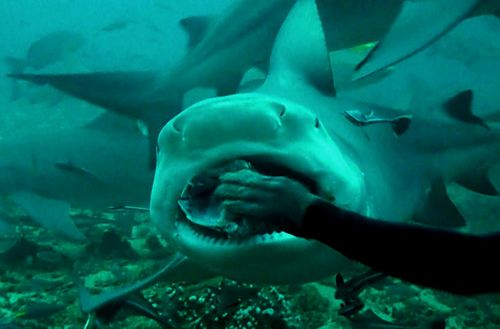Scuba diving with sharks

Sharks get a bad rap. As my dive buddy reminds me, more people will die each year from falling coconuts than from sharks. It’s taken some convincing but, I think he’s right.
Over nearly 100 dives, I've seen at least a dozen different kinds of sharks in open water. You always remember your first time. That was decades before I started diving near a reef in a warm Sri Lankan bay. The slim, gray predator startled me as it slowly swam along the bottom. I was a splashing snorkeler about 20 feet above. I paddled faster, which is actually a bad move. Flailing about on the surface makes a swimmer look more like an injured seal who might make an easy meal.
It’s also one reason surfers are quick targets for Great White Sharks. A few have been bitten just outside the surf line in San Diego. They didn't die from being eaten but from “bleeding out.” Sorry if that’s gruesome but it serves the point – sharks don’t eat humans - usually. I've read of the same thing happening in Fiji but the boy was free diving for fish and keeping his catch tied around his waist. He must have looked like a tasty target to the shark that nabbed him and once again, didn't eat him. Sadly the boy was too far from a hospital for lifesaving blood transfusions.
Given how the creatures have been so demonized and misrepresented on TV’s Shark Week and by Hollywood, I was happy to see recently that science has designed a new device to learn more about shark habits. Marine scientists don’t know that much about how sharks live. They travel vast areas and have been displaced and populations decimated for fins, which are thankfully now outlawed from California menus at least. Stories about their behavior abound, but they’re just stories and not the stuff of scientific inquiry.
A new underwater robot is making splashes in the shark research world.
An engineer, Chris Clark, and a biologist, Chris Lowe, both from Southern California colleges, have designed a shark-tracking robot to learn more about the fishes’ habits. “Working with computer scientists to answer these questions is a game changer,” Lowe told Wired Magazine. “It’s going to let us answer questions in biology that we have never been able to answer before.” Their project is unique in that they’re able to track a moving animal with this first-of-its-kind robot for sharks. Others already follow penguins, fish and marine mammals.
The worst part for the shark is the trauma of being caught, although humanely, and embedded with a transmitter tag on its dorsal fin. Soon he’s back in the open sea being shadowed by an autonomous underwater vehicle (AUV). The AUV follows at about four miles an hour and nearly 1000 feet away, so it won’t alarm the shark. “Any predator is not going to be as good a predator if it knows it’s being followed,” Lowe said in Wired. “We have programmed the robot to not disturb the shark’s behavior.”
The next element in their research is a signal from two hydrophone receivers to a computer on land. An acoustic tag is sent every second leading to mapping behavior, as well as physical and chemical sensors which relay environmental data. A picture is coming of the true habits of sharks and where they prefer to be. The hope is that hard data will inform future marine management plans.
I’d like to believe that there may be more shark fans as well as fins soon. The new data will hopefully lead to more understanding and less unreasonable fear. Divers, in my anecdotal experience, have less to worry about from sharks than other swimmers do. Divers travel in small groups and blow bubbles, both are deterrents.
I've observed shark feedings from a cage and in the open water. Once while in a line of divers creating a row of bubbles, I felt intrepid. It was the giant Tiger shark that came from behind and through the bubbles that astounded. Was she interested in the divers? Not at all. There were tasty fish heads being hand fed to many different kinds of sharks right in front of us. The Tiger swam through, a glorious and immense creature, revered by the Fijians, took a few fish heads and then disappeared again into the blue. It was a chilling but supremely intelligent and graceful act.
Rumor has it that the Chinese have been funding the harvest of shark fins in those same waters. Happily not all Fijians are involved. Those of us who appreciate the magnificent predators in their natural habitats are helping with tourist dollars to inspire preservation, not only of the sharks but the reefs and waters they call home. I hope that and scientific research will help to counter all the hyperbole about them. The next time I see a shark in the deep, I’ll keep a respectful distance but happily watch to see if a shark bot is not far behind.
Picture courtesy of Cindy Lipathay

1 comments